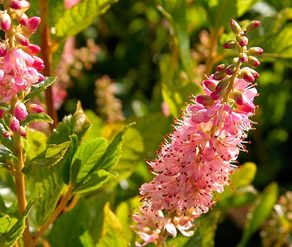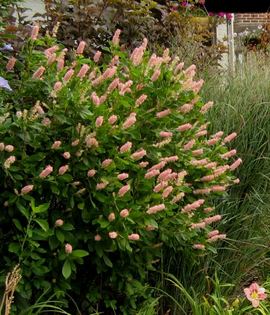 I first learned of this plant from a former colleague of mine who loved to use Summersweet in her planting plans. A gifted designer, she was thrilled to have discovered this small shade-loving shrub that’s not commonly specified and thus more unique than many of the shrubs we typically see in our region. Summersweet is also sometimes referred to as ‘Sweet Pepper Bush’ because the mature fruits --though insignificant and without any element of spiciness -- bear a resemblance to peppercorns. Botanical Name: Clethra alnifolia ‘Ruby Spice’ USDA Hardiness Zone: 4-9 Flower: Fragrant, dark pink bottlebrush-shaped flowers late summer to early fall attract bees and other pollinators. Other cultivars have white or light-pink blooms. Leaves: Small, dark green, with serrate edges --similar in appearance to Alder. A deciduous shrub, yellow fall color extends the season of interest. Sun: Prefers part shade, can tolerate full sun and still produce vivid blooms. Water: Medium to wet conditions; tolerates clay soils. Like most shade-loving plants Summersweet prefers acidic soil. Size/Habit: 3-6’ tall and wide. Attractive when planted as a hedge.  History/Symbolism/Medicine: Clethra is native to the Eastern US, where it can be invasive. The shrub is less vigorous and more manageable in our high desert climate. The genus name comes from the Greek ‘klethra’ (the name for Alder) because the small, serrate leaves have a similar look. This resemblance to alder is reiterated in the species name alnifolia as well. Alnus = Alder; Folia = leaves or foliage. Care/Propagation/Pests: Clethra is trouble-free and relatively low maintenance. To propagate, take greenwood cuttings in early summer. Uses in the Landscape: Because of its shade tolerance, Clethra makes a great understory planting. Roots will sucker under optimal growing conditions (that is, spread out to form a colony of plants), so prune back seasonally unless a naturalized look is desired. This tendency can make Summersweet a great choice for naturalized areas – say a shady berm or stream bank – where erosion control may be needed, or this filling in is otherwise welcome. Posted by Kim Warren
2 Comments
|
AuthorsArchives
January 2017
Categories |
Portfolio |
|

 RSS Feed
RSS Feed
